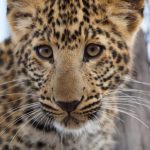
The lion is one of four big cats (genus Panthera). After the tiger it’s the second largest living cat in the world. Wild lions currently exist in Sub- Saharan Africa and a critically endangered remnant population in northwest India (Gir forest), having disappeared from North Africa, the Middle East, and Western Asia in historic times. Not many people know that also the African lion is a vulnerable species, having seen a possibly irreversible population decline of 30 to 50 per cent over the past two decades in African countries. Habitat loss and conflicts with humans are currently the greatest causes of concern.
Visually, the male lion is highly distinctive and is easily recognized by its mane. Lions are the only members of the cat family to display obvious sexual dimorphism-that is, males and females look distinctly different. They also have specialized roles that each gender plays in the pride. For instance, the lioness, the hunter, lacks the male’s thick cumbersome mane. It seems to impede the male’s ability to be camouflaged when stalking the prey and create overheating in chases. The color of the male’s mane varies from blond to black, generally becoming darker as the lion grows older. Darker-maned individuals may have longer reproductive lives and higher offspring survival, although they suffer in the hottest months of the year. In prides including a coalition of two or three males, it is possible that lionesses solicit mating more actively with the males who are more heavily maned. Lions live for around 10-14 years in the wild, while in captivity they can live over 20 years. In the wild, males seldom live longer than ten years, as injuries sustained from continuous fighting with rival males greatly reduces their longevity.
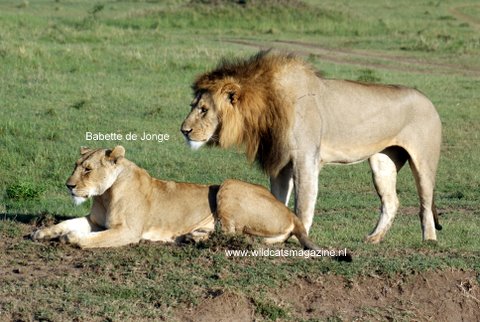
Lions typically inhabit savanna and grassland, although they may take to bush and forest. Lions are social compared to other cats. A pride of lions consists of related females and offspring and a small number of adult males. Groups of female lions typically hunt together, preying mostly on large ungulates. Lions mostly hunt themselves, although they will scavenge if the opportunity arises.
With powerful legs, a strong jaw, and long canine teeth, the lion can bring down and kill large prey. The skull of the lion is very similar to that of the tiger, though the frontal region is usually more depressed and flattened, with a slightly shorter postorbital region. The lion’s skull has broader nasal openings than the tiger. However, due to the amount of skull variation in the two species, usually, only the structure of the lower jaw can be used as a reliable indicator of species. Lion coloration varies from light buff to yellowish, reddish, or dark ochraceous brown. The underparts are generally lighter and the tail tuft is black. Lion cubs are born with brown rosettes (spots) on their body, rather like those of a leopard. Although these fade as lions reach adulthood, faint spots often may still be seen on the legs and underparts, particularly on lionesses.
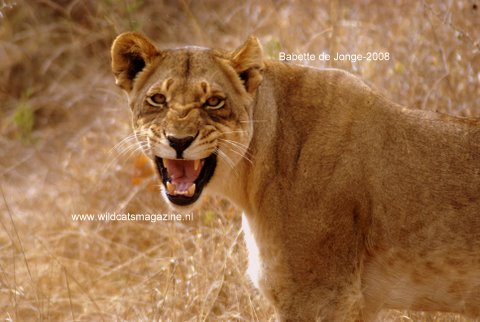
The white lion is not a distinct subspecies, but a special morph with a genetic condition, leucism, that causes paler colouration. They are not albinos, having normal pigmentation in the eyes and skin. White Transvaal lion (Panthera leo krugeri) individuals occasionally have been encountered in and around Kruger National Park and the adjacent Timbavati Private Game Reserve in eastern South Africa, but are more commonly found in captivity, where breeders deliberately select them. The unusual cream color of their coats is due to a recessive gene. Reportedly, they have been bred in camps in South Africa for use as trophies to be killed during canned hunts.
Lions spend much of their time resting and are inactive for about 20 hours per day. Although lions can be active at any time, their activity generally peaks after dusk with a period of socializing, grooming, and defecating. Intermittent bursts of activity follow through the night hours until dawn, when hunting most often takes place. They spend an average of two hours a day walking and 50 minutes eating.
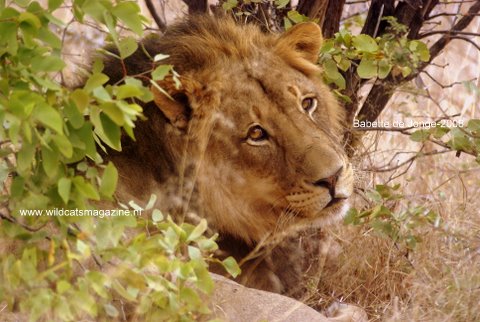
Lions are predatory carnivores who manifest two types of social organization. Some are residents, living in groups, called prides. The pride usually consists of approximately five or six related females, their cubs of both sexes, and one or two males (known as a coalition if more than one) who mate with the adult females (although extremely large prides, consisting of up to 30 individuals, have been observed). The coalition of males associated with a pride usually amounts to two, but may increase to four and decrease again over time. Male cubs are excluded from their maternal pride when they reach maturity.
The second organizational behaviour is labeled nomads, who range widely and move about sporadically, either singularly or in pairs. Pairs are more frequent among related males who have been excluded from their birth pride. Note that a lion may switch lifestyles; nomads may become residents and vice versa. Males have to go through this lifestyle and some never are able to join another pride. A female who becomes a nomad has much greater difficulty joining a new pride, as the females in a pride are related, and they reject most attempts by an unrelated female to join their family group.
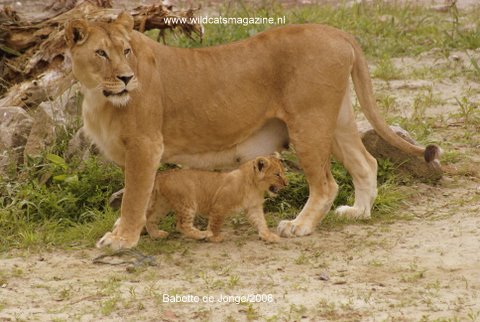
Lionesses do the majority of the hunting for their pride, being smaller, swifter and more agile than the males, and unencumbered by the heavy and conspicuous mane, which causes overheating during exertion. They act as a co-ordinated group in order to stalk and bring down the prey successfully. However, if nearby the hunt, males have a tendency to dominate the kill once the lionesses have succeeded and eaten. They are more likely to share with the cubs than with the lionesses, but rarely share food they have killed by themselves. Smaller prey is eaten at the location of the hunt, thereby being shared among the hunters; when the kill is larger it often is dragged to the pride area. There is more sharing of larger kills, although pride members often behave aggressively toward each other as each tries to consume as much food as possible.
Both males and females defend the pride against intruders. Some individual lions consistently lead the defense against intruders, while others lag behind. Lions tend to assume specific roles in the pride. Those lagging behind may provide other valuable services to the group. An alternative hypothesis is that there is some reward associated with being a leader who fends off intruders and the rank of lionesses in the pride is reflected in these responses. The male or males associated with the pride must defend their relationship to the pride from outside males who attempt to take over their relationship with the pride. Females form the stable social unit in a pride and do not tolerate outside females; membership only changes with the births and deaths of lionesses, although some females do leave and become nomadic. Subadult males on the other hand, must leave the pride when they reach maturity at around 2-3 years of age.

Lions are powerful animals that usually hunt in coordinated groups and stalk their chosen prey. However, they are not particularly known for their stamina. They sneak up to the victim until they reach a distance of approximately 30 metres (98ft) or less. Typically, several lionesses work together and encircle the herd from different points. Once they have closed with a herd, they usually target the closest prey. The attack is short and powerful; they attempt to catch the victim with a fast rush and final leap. The prey usually is killed by strangulation. Smaller prey, though, may simply be killed by a swipe of a lion’s paw. The prey consists mainly of large mammals, with a preference for wildebeest, impalas, zebras, buffalo and warthogs in Africa and nilgai, wild boar and several deer species in India. Many other species are hunted, based on availability, like even elephant and giraffe.
Because lionesses hunt in open spaces where they are easily seen by their prey, cooperative hunting increases the likelihood of a successful hunt; this is especially true with larger species. Teamwork also enables them to defend their kills more easily against other large predators such as hyenas, which may be attracted by vultures from kilometers away in open savannas. Lionesses do most of the hunting; males attached to prides do not usually participate in hunting, except in the case of larger quarry such as giraffe and buffalo. In typical hunts, each lioness has a favored position in the group, either stalking prey on the “wing” then attacking, or moving a smaller distance in the centre of the group and capturing prey in flight from other lionesses. Young lions first display stalking behavior around three months of age, although they do not participate in hunting until they are almost a year old. They begin to hunt effectively when nearing the age of two.
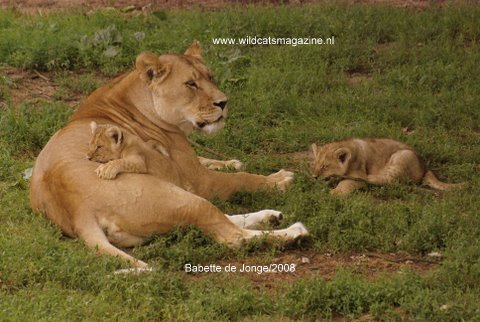
The average gestation period is around 110 days, the female giving birth to a litter of one to four cubs in a secluded den (which may be a thicket, a reed- bed, a cave or some other sheltered area) usually away from the rest of the pride. She will often hunt by herself whilst the cubs are still helpless, staying relatively close to the thicket or den where the cubs are kept. The cubs themselves are born blind-their eyes do not open until roughly a week after birth. At first they are blind and almost helpless, beginning to crawl a day or two after birth and walking around three weeks of age. The lioness moves her cubs to a new den site several times a month, carrying them one by one by the nape of the neck, to prevent scent from building up at a single den site and thus avoiding the attention of predators that may harm the cubs.
Usually, the mother does not integrate herself and her cubs back into the pride until the cubs are six to eight weeks old. However, sometimes this introduction to pride life occurs earlier, particularly if other lionesses have given birth at about the same time. For instance, lionesses in a pride often synchronize their reproductive cycles so that they cooperate in the raising and suckling of the young (once the cubs are past the initial stage of isolation with their mother), who suckle indiscriminately from any or all of the nursing females in the pride. In addition to greater protection, the synchronization of births also has an advantage in that the cubs end up being roughly the same size, and thus have an equal chance of survival. If one lioness gives birth to a litter of cubs a couple of months after another lioness, for instance, then the younger cubs, being much smaller than their older brethren, are usually dominated by larger cubs at mealtimes-consequently, death by starvation is more common amongst the younger cubs.
In addition to starvation, cubs also face many other dangers, such as predation by jackals, hyenas, leopards, martial eagles and snakes. Even buffaloes, should they catch the scent of lion cubs, often stampede towards the thicket or den where they are being kept, doing their best to trample the cubs to death whilst warding off the lioness. Furthermore, when one or more new males oust the previous male(s) associated with a pride, the conqueror(s) often kill any existing young cubs, because females do not become fertile and receptive until their cubs mature or die. All in all, as many as 80 percent of the cubs will die before the age of two. Killing of cubs by the mother, like occasionally happens in captivity, is rarely seen in the wild. The lioness must be disturbed or convinced there’s something wrong with the health of her cubs.
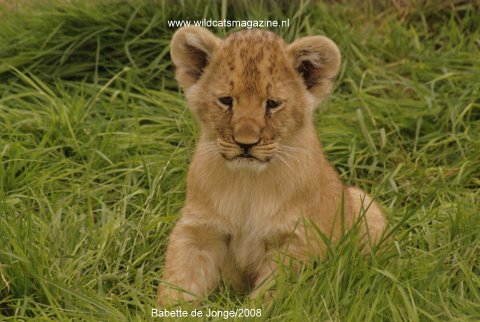
When first introduced to the rest of the pride, the cubs initially lack confidence when confronted with adult lions other than their mother. However, they soon begin to immerse themselves in the pride life, playing amongst themselves or attempting to initiate play with the adults. Lionesses with cubs of their own are more likely to be tolerant of another lioness’s cubs than lionesses without cubs. The tolerance of the male lions towards the cubs varies-sometimes, a male will patiently let the cubs play with his tail or his mane, whereas another may snarl and bat the cubs away.
One scientific study reports that both males and females may interact homosexually. Male lions pair-bond for a number of days and initiate homosexual activity with affectionate nuzzling and caressing, leading to mounting and thrusting. A study found that about 8 percent of mountings have been observed to occur with other males. Female pairings are held to be fairly common in captivity, but have not been observed in the wild.
Though adult lions have no natural predators, evidence suggests that the majority die violently from humans or other lions. This is particularly true of male lions, who, as the main defenders of the pride, are more likely to come into aggressive contact with rival males. In fact, even though a male lion may reach an age of 15 or 16 years if he manages to avoid being ousted by other males, the majority of adult males do not live to be more than 10 years old. This is why the average lifespan of a male lion tends to be significantly less than that of a lioness in the wild. However, members of both sexes can be injured or even killed by other lions when two prides with overlapping territories come into conflict.

